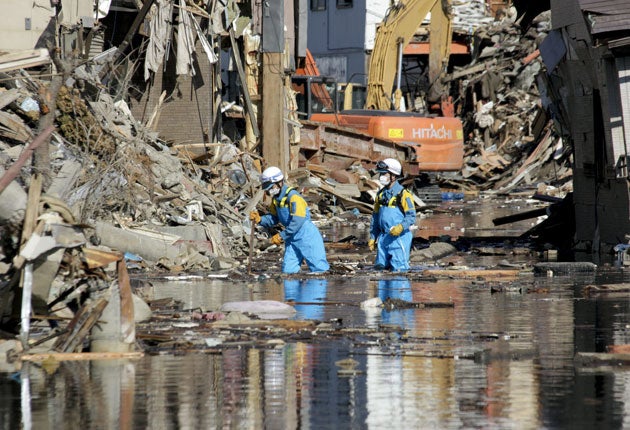Fight to stop Fukushima radiation leaks 'could take nine months'
Aftershocks and power cuts hamper 'cold shutdown' of stricken nuclear plant

The company at the centre of the world's worst nuclear crisis since Chernobyl has announced that it could be nine months before the Fukushima Daiichi plant is under full control, tripling some previous forecasts.
The new estimate came as the US Secretary of State Hillary Clinton touched down in Tokyo in a show of solidarity with Japan's beleaguered government. Tokyo Electric Power Co (Tepco) said it will take three months to reduce radiation and restore the plant's cooling systems to the overheating uranium fuel.
Another three to six months will then be needed before the reactors stabilise and radiation is completely plugged, Tepco chairman Tsunehisa Katsumata told reporters yesterday.
"We sincerely apologise for causing troubles," said Mr Katsumata, who revealed that he might resign his position amid withering criticism of the utility's handling of the disaster. "We are doing our utmost to prevent the crisis from further worsening."
Tepco is under enormous pressure to resolve the nuclear crisis triggered by last month's huge earthquake and tsunami, which knocked out the plant's cooling systems. At least two reactors have partially melted down and are leaking radiation, including cesium and plutonium, one of the planet's most toxic substances.
The company has already dumped thousands of tonnes of toxic water into the Pacific Ocean, but faces a build-up of contaminated water on site after weeks of using fire hoses and helicopters to shower it with seawater. The battle to bring the nuclear plant safely to "cold shutdown" is being hampered by continued aftershocks and power cuts.
On Saturday, a spike in seawater levels of iodine-131 caused concerns that the plant had sprung a new leak. The government said that the levels were 6,500 times the legal limit, up from 1,100 the previous day. At its peak last month, radioactive iodine in the sea around the complex was recorded at 7.5 million times safe levels.
Mr Katsumata also said that on-site workers were trying to prevent further hydrogen explosions in reactors one, two and three. Three of the buildings housing the plant's six reactors were badly damaged by similar blasts in the week after the quake on 11 March.
The explosions showered the surrounding countryside with radioactivity, forcing thousands of people to evacuate. Japan's Trade Minister Banri Kaieda said yesterday that it may be safe for some of the evacuees to return by the end of the year. "Of course, some people will be unable to return home, but we will keep everyone informed," he said. Engineers at the Fukushima plant, about 250km north-east of Tokyo, face a series of complex challenges.
The head of the Atomic Energy Society of Japan, Takashi Sawada, said last week that fuel rods in reactors one and three have melted and settled at the bottom of their containment vessels, confirming fears that the plant suffered a partial meltdown. After stopping the radiation leaks, the engineers must dispose of the toxic water, and decontaminate and dismantle the reactors – a job that is likely to take decades to complete.
The tough task is complicated by the presence of highly contaminated nuclear waste in ponds beside the reactors, containing huge quantities of radioactive cesium-137.
Ms Clinton, on a one-day trip to the capital, praised the government's handling of the crisis and said she was confident that Japan would recover. "The constant efforts to respond to the situation at Fukushima have required intense analysis by Japanese, American and international experts, and we have been very supportive of what Japan is doing to take the appropriate steps," she said after meeting the Prime Minister, Naoto Kan.
American nuclear engineers are reportedly also involved in the nuclear plant battle. Another 2,000 US troops have been dispatched to help survivors of the 11 March disaster, mainly in Japan's north-east, which has left about 28,000 people dead or missing.
The Japan disaster in numbers
48,000 The estimated number of families living within a 30km radius of the Fukushima plant who have left their homes
20km The radius of the exclusion zone around the nuclear power station. The US embassy in Tokyo advises that its citizens avoid going within 80km of the plant
$15,000 The initial payout Tepco promised to affected families
6,500 The number of times above the legal radiation level that was recorded in the sea near the nuclear power plant on Saturday
Subscribe to Independent Premium to bookmark this article
Want to bookmark your favourite articles and stories to read or reference later? Start your Independent Premium subscription today.

Join our commenting forum
Join thought-provoking conversations, follow other Independent readers and see their replies